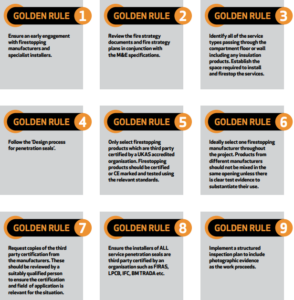Introduction
Fire safety is paramount in UK construction, with passive fire protection systems playing a pivotal role. However, it’s surprising how frequently these crucial systems, like firestopping and compartmentation, are neglected and addressed only as an afterthought. These silent heroes work diligently behind the scenes, containing smoke and fire, safeguarding lives, and preventing property damage. To ensure their effectiveness, it is imperative to prioritize passive fire protection from the project’s outset. In this blog post, we delve into the importance of early engagement in passive fire protection, with a special focus on Golden Rule Number 1, as outlined in the ASFP’s “Firestopping of Service Penetrations Best Practice in Design and Installation” document.

Firestopping and Compartmentation
Firestopping: This is defined as the sealing of openings or penetrations in fire-rated walls, floors, and ceilings, maintaining their fire-resistance ratings. It prevents the rapid spread of fire and smoke across fire compartments through service penetrations.
Compartmentation: Compartmentation divides a building into fire-resistant compartments, limiting the horizontal and vertical spread of fire. It’s a crucial defence mechanism, allowing occupants more time to escape and firefighters more control over the fire.
The Value of Early Engagement in Passive Fire Protection
Understanding the critical concept of early engagement is essential. The ASFP’s “Firestopping of Service Penetrations Best Practice in Design and Installation” document underscores the “Golden Thread” approach to fire safety, built on four key principles. In this post, we emphasize Golden Rule Number 1: Commence with a Sound Design.
The Golden Thread: A Brief Overview
The Golden Thread, central to the Hackitt report, advocates for transparent documentation of fire safety features throughout a building’s lifecycle. It ensures that all stakeholders, from designers to contractors to building owners, comprehend and uphold these features.
Dame Judith Hackitt’s “Building a Safer Future” report called for the establishment of a ‘golden thread’ supporting duty holders in designing, constructing, and managing their buildings as holistic systems, incorporating building safety at all lifecycle stages. The government committed to implementing Hackitt’s recommendations regarding the golden thread.
The Building Regulations Advisory Committee (BRAC) golden thread working group united industry experts to aid officials in developing golden thread policy.
The RACI Model
In the context of early engagement, contractors should adopt the RACI model:
Responsible: Identify those responsible for specific passive fire protection tasks, such as designers, contractors, and specialists.
Accountable: Designate a single individual with ultimate accountability for passive fire protection measures, such as the project manager or lead designer.
Consulted: Specify individuals or teams that need to be consulted during passive fire protection design and implementation, including fire engineers or safety experts.
Informed: Identify stakeholders who must stay informed about passive fire protection progress and decisions, such as building owners or regulatory authorities.
A key performance indicator is the successful delivery of compliant penetration seals, supported by comprehensive documentation, including product certification.
Benefits of Early Engagement
Engaging with passive fire protection at the project’s inception offers several advantages:
Regulatory Compliance: A well-considered design ensures immediate compliance with building regulations and fire safety standards.
Risk Mitigation: Early engagement identifies and mitigates potential fire protection challenges, reducing the risk of costly redesigns or compliance issues.
Cost Efficiency: Addressing passive fire protection requirements upfront leads to substantial cost savings, preventing expensive retrofits or corrections.
Collaboration and Communication: Early engagement fosters better collaboration and communication among stakeholders, seamlessly integrating fire safety into the project.
Sustainability: Considering passive fire protection from the outset allows the selection of durable, cost-effective solutions aligned with the building’s expected lifespan.
In conclusion, passive fire protection transcends being a mere item on a procurement checklist; it’s fundamental to building safety. By prioritizing early engagement and adhering to established guidance principles, companies can enhance safety, reduce risks, and create buildings with effective fire compartments. To ensure compliance with current regulations and obtain expert assistance with passive fire protection, contact us at info@murusfire.co.uk.
